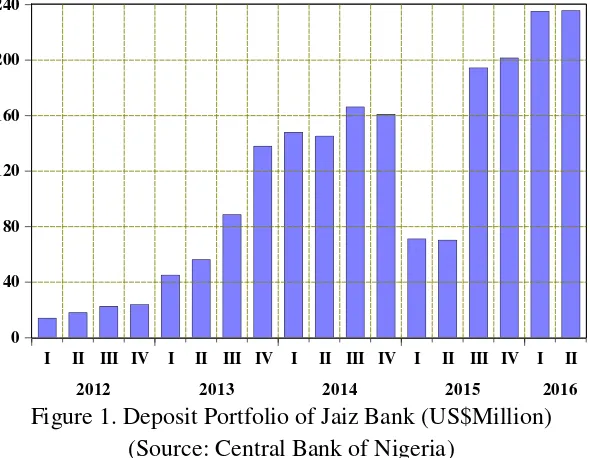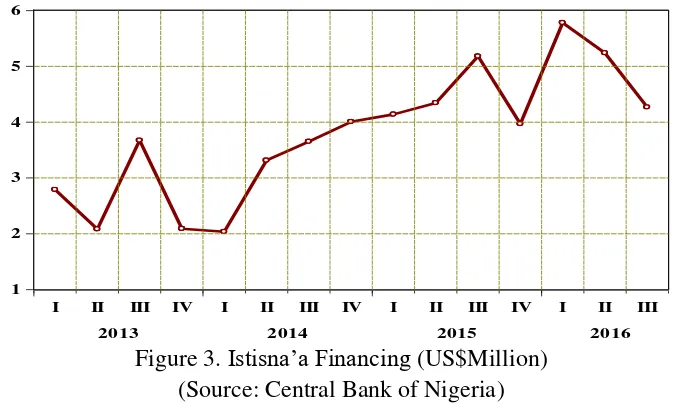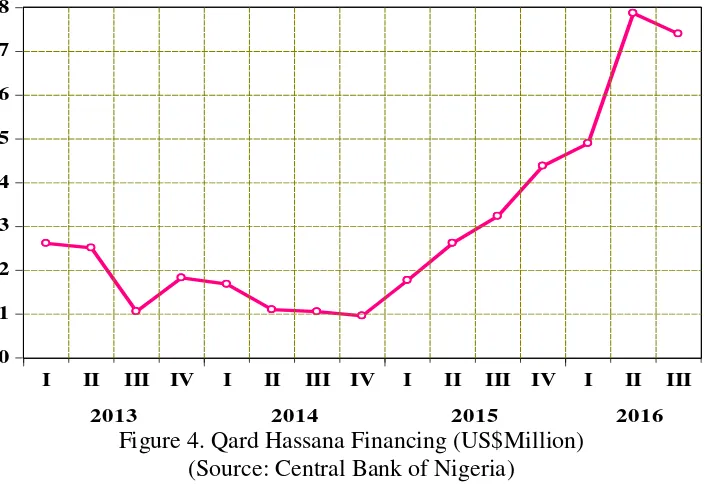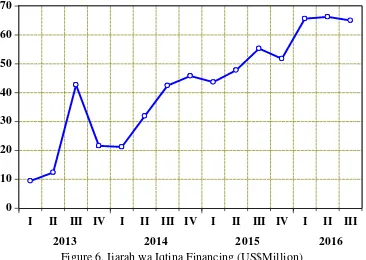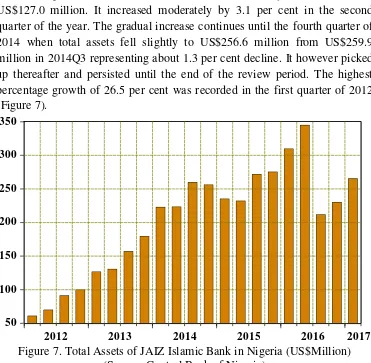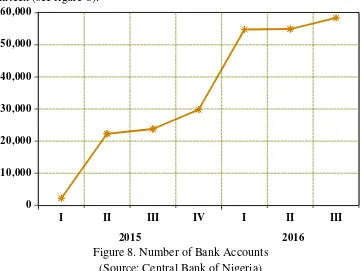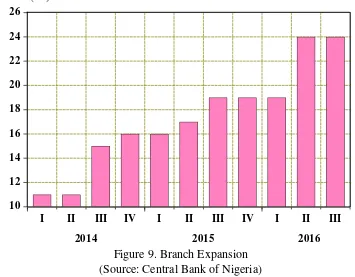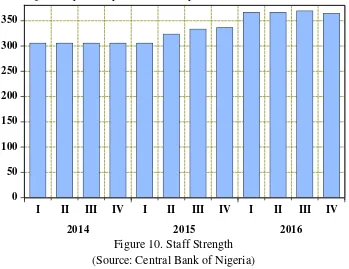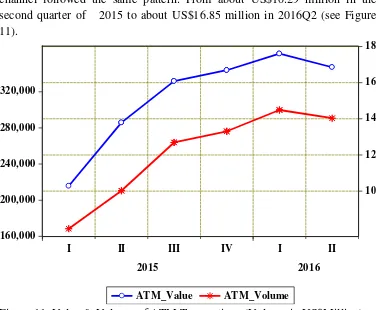FINANCIAL INCLUSION AND DEEPENING IN NIGERIA:
Department of Economic, Usmanu Danfodiyo University Sokoto, Nigeria. *1
Email: [email protected], [email protected]
ABSTRACT - The Central Bank of Nigeria in 2012, as a sign of her commitment to the 2011 Maya Declaration, developed a financial inclusion strategy for Nigeria. The aim of the strategy, amongst others, was to reduce the percentage of adult Nigerians excluded from financial services from 46.3 per cent as at 2010 to 20.0 per cent by 2020 with the view to enabling them have access to financial services, engage in economic activities and contribute to the growth and development of the country. The number of Nigerians that are included in the formal sector shall then increase from 30.0 per cent in 2010 to 70.0 per cent by the year 2020. By this, Nigeria had committed herself to reducing the population of unbanked and under-banked adults by about 50.0 per cent by the year 2020. Maya declaration recognises the criticality of inclusive financing to not only inclusive growth but also global financial stability, financial deepening and poverty reduction for about 2.5 billion unbanked adults across the globe. This study is a maiden attempt to explore the contribution of the recently established non-interest bank (Jaiz bank) in Nigeria towards the reduction of both the unbanked and under-banked adult population since its inception in 2012. The study used an exploratory approach and concludes that Jaiz bank is immensely helping the country in her quest to satisfy the Maya commitments. The study recommends, among others that special consideration should be given to banks of such standings to
aid rapid expansion of access to finance for Nigerians who ordinarily wouldn’t have easy access to
banking facilities.
Keywords: Financial inclusion, financial deepening, Non-interest bank, financial services
ABSTRAK – Inklusi Keuangan dan Pendalamannya di Nigeria: Kontribusi Bank Jaiz. Sebagai bagian dari komitmennya terhadap Deklarasi Maya 2011, Bank Sentral Nigeria pada tahun 2012 mengembangkan strategi inklusi keuangan untuk Nigeria. Tujuannya, antara lain, adalah untuk mengurangi persentase jumlah orang dewasa di Nigeria yang belum tersentuh jasa keuangan dari 46,3 persen pada 2010 menjadi 20,0 persen pada 2020 sehingga memungkinkan mereka memiliki akses ke layanan keuangan, berperan dalam kegiatan ekonomi dan berkontribusi pada pembangunan negara. Harapannya, jumlah orang Nigeria yang masuk dalam sektor formal akan terdongkrak dari 30,0 persen pada tahun 2010 menjadi 70,0 persen pada tahun 2020. Untuk itu, Nigeria telah berkomitmen untuk mengurangi jumlah orang yang unbanked dan under-banked sekitar 50,0 persen pada tahun 2020. Deklarasi Maya mengakui pentingnya pembiayaan inklusif yang ditujukan tidak hanya untuk pertumbuhan inklusif tetapi juga stabilitas keuangan global, pendalaman keuangan, dan pengurangan kemiskinan bagi sekitar 2,5 miliar orang yang unbankable di seluruh dunia. Penelitian ini adalah upaya perdananya untuk mengeksplorasi kontribusi bank non-bunga (Jaiz bank) yang baru didirikan di Nigeria terhadap pengurangan jumlah orang yang unbanked dan under-banked sejak didirikannya pada tahun 2012. Penelitian ini menggunakan pendekatan eksplorasi dan menyimpulkan bahwa Bank Jaiz memiliki kontribusi yang sangat besar dalam membantu Nigeria untuk memenuhi komitmennya terhadap deklarasi Maya. Kajian ini, antara lain, merekomendasikan bahwa pertimbangan khusus harus diberikan kepada bank-bank yang mempunyai peran sejenis untuk mempercepat perluasan akses keuangan bagi masyarakat Nigeria yang selama ini kesulitan dalam mengakses fasilitas perbankan.
INTRODUCTION
The 2011 Maya declaration is the first measurable global set of commitments by emerging markets and developing countries to strengthen effort to unlock the economic and social potentials of about 2.5 billion poorest people of the world through greater financial inclusion. This declaration was endorsed by more than eighty (80) institutions across the globe, representing over 70.0 per cent of the world estimated unbanked and under-banked population. The Maya declaration recognises the importance of inclusive financing to not only inclusive growth but also global financial stability, financial deepening and poverty reduction. Four areas, highly interconnected with the popular G20 principles for innovative financial inclusion, were broadly accepted as focal points. These areas include: the creation of enabling environment for the adoption and application of new technology that facilitate increasing access, with lower cost to financial services; implementation of proportional framework that advances synergies in financial inclusion, integrity and stability; integration of consumer protection and empowerment as a key pillar of financial inclusion and the use of data to make informed policy as well as tracking of the results.
The Central Bank of Nigeria in 2012, as a sign of her commitment to the Maya Declaration, developed a financial inclusion strategy for Nigeria. The aim of the strategy, amongst others, was to reduce the percentage of adult Nigerians excluded from financial services from 46.3 per cent as at 2010 to 20.0 per cent by 2020 with the view to enabling them have access to financial services, engage in economic activities and contribute to growth and development of the country. The number of Nigerians that are included in the formal financial sector shall then increase from 30.0 per cent in 2010 to 70.0 per cent by the year 2020. By this, Nigeria had committed herself to reducing the population of unbanked and under-banked adults by about 50.0 per cent by the year 2020. Financial services covered include but not limited to payments, savings, loans, insurance, and pension products.
developmental characteristics as well as summarily explores the legal and regulatory framework for NIBs in Nigeria. Section three briefly discusses countries experiences in the use of non-interest banks as an instrument of inclusive financing, section four examines the contribution of the existing NIB to financial inclusion and deepening in Nigeria and the last section concludes the paper and offer some policy advice.
LITERATURE REVIEW
Key Principles of Islamic Financing
The basis for Islamic financing centres majorly on the Islamic norm of justice,
fair play and harmony with reality and human nature (Kahf, 1998). The core
principles of Islamic finance are entrenched largely in the rulings of the Islamic legal code. This is because Islamic legal jurisprudence does not draw any thick line between spiritual acts and other aspects of life including but not limited to political, economic and social aspects (Muamalat). Thus, three succinctly clear key principles governing Islamic finance are distillable from Islamic legal code, namely; equity, participation and ownership. Each of these principles is explained in-turn.
Equity: This is the principle that tends to protect the relatively weaker party in any financial transaction. It provides the basis for not only the prohibition
of a predetermined payment popularly referred to as interest (riba) but also
excessive uncertainty arising from ambiguity in contracts or elusiveness of
pay-off (gharar). Transacting parties are rather encouraged not only to share
in the gains of financial transactions but also genuine loss arising therefrom. They are also morally duty bound to disclose full information without reservation at the onset of any contractual agreement so as to avoid information asymmetry, hence the contract is null and void. The concept of zakat, which is compulsory on all well to-do Muslims, also takes its foundation from the principle of equity. Zakat ensures equitable distribution of wealth with its inherent tendency to galvanise social solidarity.
Participation: This principle enhances productivity and it is critical to Islamic finance. Return on capital is not only a function of time but also the associated risk. This ensures that return on wealth emanates from productive and economically beneficial activities. Based on these principles, the
implies that reward should also be accompanied by risk taking such that the anticipated return on investment could take any direction.
Ownership: The principle of ownership is also very important in contractual arrangement. Contractual parties are not permitted to sell what is not lawfully theirs. It is therefore pertinent that Islam requires preservation and respect for property rights
Developmental Characteristics of Islamic Finance
Following Mohamed and Seifallah (2010), there are three major developmental characteristics of Islamic finance, namely: productive, moral and ethical as well as relational characteristics. Each can be explained in-turn as follows:
The Productive Characteristics
The direct link between financing in Islam and the real sector of the economy makes it highly distinct from its conventional counterpart. Prominent among
the financing modes in Islam such as Mudaraba, Musharaka, etc goes to
productive ventures which are the drivers of growth, provides employment and hence improves human welfare. The profit accrued to the ventures that benefited from Islamic finance are shared, on an agreed term, between the
venture and the financier. If we consider Murabaha, for instance, it is a
deferred lump sum sale or cost plus profit sale (Ibrahim & Fitria, 2012). A situation whereby the product is delivered immediately and the price paid in a lump sum at a later pre-agreed date or by fixed instalment. It is mostly used in financing trade, particularly imports or exports or providing working capital for business. In a nutshell, therefore, Islamic mode of financing pays attention to profitability arising from value addition and hence discourages financing modes such as debt rescheduling or swap and speculative transfer or dealings. This is in contrast to the conventional modes of financing that concentrates only on the ability to repay without due consideration for possibility of genuine losses.
The Moral and Ethical Characteristics
Prominent among such goods and activities includes but not limited to alcoholic drinks, tobacco, heroin, and gambling. They also strive to as much
as possible avoid gharar (excessive speculation, uncertainty in contract and
lack of transparency).
The Relational Characteristics
Relational characteristic is the third developmental characteristics of Islamic financing. It bothers on depositors-employees relationships. The essence of mobilising deposits, unlike in the conventional banking arrangement, is not solely to serve as an intermediary between the surplus and deficit spending units. Islamic banks relationships with the depositors are also to facilitate investment. This is very much unlike the conventional banks that mobilise deposits from the depositors for interest. The Islamic model enhances competition which in-turn optimises profitability both for the depositors as well as the shareholders.
The basis for competition in the Islamic financing goes beyond the financial performance of the banks to include reputational concerns, as every activity of Islamic banks must be in conformity with the injunctions of Islam. This enables the attainment of dual positive outcomes. First, it optimises the interaction between the institutions and the depositors, facilitates cooperation, boost internal efficiency and legitimacy. Second, it boosts the corporate image of the participating institutions.
Legal Framework for Non-Interest Banking in Nigeria
The Central Bank of Nigeria derives her power for the licensing of NIBs from section 33 (1b) of the CBN Act 2007; Sections 23(1) 52; 55(2); 59(1)(a); 61 of Banks and Other Financial Institutions Act (BOFIA) 1991 (as amended) and Section 4(1c) of the Regulation on the Scope of Banking Activities and Ancillary Matters, No. 3, 2010.
The New Banking Model of the Central Bank of Nigeria (CBN), which was introduced in 2011, authorizes the establishment of three types of banking structures as contained in the BOFIA act 1991 as amended:
a) Commercial Banks;
b) Merchant Banks; and
The specialised banks includes include non-interest banks, microfinance banks, development banks, mortgage banks and any other banking model that the CBN may deemed fit from time to time. The commercial banks are further grouped into three; namely: international banks with a minimum capital base of about US$368.0 million, national which is expected to have a minimum capital base of US$184.0 million and regional with a paid up minimum capital of US$73.6 million.
The new banking framework defined Non-Interest Financial Institutions as banks or other financial institution (OFI) under the supervision of the CBN, which performs banking business, involves in trading as well as investment and commercial activities and provides financial products and services in line with the regulations guiding non-interest banking principles. The framework broadly categorised non-interest banking and finance models into two; namely: non-interest banking and finance based on Islamic commercial jurisprudence; and non-interest banking and finance based on any other Islamic banks will operate in accordance with principles and rules of Islamic commercial jurisprudence which recognises the principle of profit and loss sharing as against interest.
The guideline listed other non- permissible transactions to include; uncertainty or ambiguity relating to the subject matter, terms or conditions
(gharar), gambling, speculation, unjust enrichment, exploitation/unfair trade practices, dealings in pork, alcohol, arms & ammunition, pornography as well as other transactions, products, goods or services which are not compliant with the rules and principles of Islamic commercial jurisprudence.
mortgage institution that would offer Islamic financial services either full-fledged or as a subsidiary but to be licensed by the CBN as well as a finance company to operate either full- fledged or as a subsidiary.
Countries Experiences with NIB as an Instrument of Financial Deepening
The Shariah complaint financial institutions is said to have since been on the rise. It was estimated to be about 1.0 per cent of the total world assets as at 2014 translating to about US$2.0 trillion (WIFM, 2015). There were about 300 banks and 250 mutual funds across the globe in 2009 that complies with either partially or fully with Islamic principles. Although, according to Yueh (2014), Islamic banking still covers a small fraction of the banking assets of Muslims, it grew at an annual average rate of 17.6 per cent between 2009 and 2013 and expected to grow on the average by 19.7 per cent thereafter until 2018, translating to over US$3.5 trillion. This pace is faster than the growth of total banking assets.
Although, there is concentration of Islamic Finance assets in the emerging markets of Gulf Cooperation countries and South East Asia, it is present in
seventy countries1 with more than six hundred financial institutions. A
remarkable size is also domicile in the advanced countries such as the US and Europe, including the UK.
The United Kingdom
Islamic Banking has been in the UK for over three decades. The country has one of the most developed Islamic Financial Institution in the Europe. The first Islamic bank, Al-Baraka International was established in 1982 with the
first commodity, Murabaha transactions. Sukuk was launched in 2005 and
2010, the second corporate sukuk was issued by International Innovative
Technologies Ltd. In 2013 the government established the first Islamic Finance Task force and the Islamic Financial Institutions are now under the regulation of both the Bank of England and the Financial Services Authority
(Filippo et al, 2013).
As at 2014, there are over twenty banks in the UK that offer Islamic financial products and services with over six fully Sharia complaint, serving both
Muslims and non-Muslims2. For instance, application for savings of the
Islamic Bank of Britain by non-Muslims surged in 2014 by about 55.0 per
1 Including the UK, US, UAE, Malaysia, China, Singapore, South Africa, Kenya among many others.
cent. The treasury of the UK sold over 200 million pound worth of Islamic
government bonds (Sukuk) in 2014 making Britain the first country outside
the Islamic world to issue Islamic bonds. As at June 2015, the Islamic finance investment bonds raise in the London exchange had exceeded US$51.0 billion through fifty-seven issues. The Stock Exchange has a very vibrant market in
exchange traded funds out of which four are fully Shari’ah-compliant
(London Exchange, 2016). Well over seventeen leading Global financial institutions have set up special branches or subsidiary firms transacting in financial instruments in the UK. These include Barclays, Royal Bank of Scotland (RBS), Hongkong and Shanghai Banking Corporation (HSBC), Citibank, Lloyds TSB Banking Group, among many others (Waseem, 2008). Islamic Banks in the UK funded either wholly or in part the Shard, Chelsea Barracks, Harrods and the Olympic Village.
The Islamic financing, however, received the most prominent political and regulatory support in 2000, through a working group spearheaded by the Bank of England as well as representatives of the Treasury, financial services
capitals of Islamic finance anywhere in the world”.
The United States
As at 2014, the US has about nineteen (19) financial institutions providing
either fully or partially shari’ah compliant financial services. This includes
but not limited to retail banking services, investment banking, mortgage companies as well as community based financing institutions (Abdi, 2009).
The first attempt at Islamic financing was in the mid-1990s when Ijarah and
Mudarabah modes of financing became formally appealing to the Office of the Comptroller of the Currency for mortgage transactions. In 1999 Islamic Market Index was created in the Dow Jones for investors interested in Islamic
compliant equities (Filippo et al, 2013). As at 2013, the total assets under the
management of Islamic finance institutions was estimated at US$3.6 billion, representing about 7.9 per cent of global Islamic fund. General Electric
Capital Corp issued an Ijarah to the tune of US$500.0 million in 2009 with a
The Goldman Sachs, issued a US$500.00 million Wakalah sukuk, a transaction which according WIFM (2015) attracted an order book of US$1.5 billion. There was another worth US$500.00 million with a tenor of three years under the administration of International Finance facility for Immunisation.
South Africa
A full fledge Islamic finance commenced in South Africa in 1989 with the establishment of Al Baraka besides HBZ Bank house which operates an Islamic window side by side with conventional banking services. As at 2014, the total Islamic banking assets in South Africa amounted to about 2.0 per cent of total banking assets. In addition to the full fledge Islamic banks, there are over eleven asset management companies offering various Sharia compliant investment services
The regulatory agencies in South Africa have developed and promote Islamic financing. The regulatory agencies in May 2010 amended the South African tax laws to accommodate institutions offering Islamic financial services so as to create equitable and level playing ground for Islamic financing institutions in the country.
Malaysia
Malaysia is recognised as the hub of Islamic finance and carries the largest Islamic bond market across the globe. Malaysia has a total of fifty-eight different financial institutions transacting in Islamic products at varying levels. Twenty out which are banks, sixteen operates Islamic windows, nine
are Islamic fund management companies, eight Takaful companies and four
re-Takaful operators and one international Takaful operator (Enrique et al.,
2014). The country had since 2001 established an Islamic Capital Market with varying products. The Dow Jones launched the Islamic Malaysia index in
2005 to track over forty-five shari’ah compliant companies. The country also
established in 2005, a deposit insurance system, the Perbadanan Insurans
Deposit Malaysia (PIDM). The country also in 2006 launched an International Finance Centre Initiative which is saddled with the responsibility of holding
Although, according to Enrique et al. (2014), Islamic financial services started in Malaysia as early as 1963, when small Islamic financial institutions were managing funds for intending Muslim pilgrims, but full fledge Islamic
financing became operational in 1983 when ‘Bank Islam Malaysia Berhard’
was granted a full fledge Islamic banking license, following the enactment of Islamic Banking Act in the year as well as the establishment of dispute
settlements mechanism and issuance of shari’ah compatible investment
certificate.
RESULT AND DISCUSSION
The study uses financial deepening indicators in line with the broader definition of Levine (2005), who viewed financial deepening as a situation when financial markets, instruments and stakeholders interact to reduce the cost of contract enforcement, transaction and information in order to perform principally five tasks which includes: facilitation of the exchange of goods and services; mobilisation of savings; allocation of savings to the most productive sectors of the economy; tracing of investment performance and entrenchment of corporate governance; and diversification as well as reduction of both liquidity and inter-temporal risks. To this effect, this study utilises deposit liabilities, financing facilities and total assets to proxy the contribution of Jaiz bank to financial deepening. The study uses end-period exchange rate to convert domestic currency (i.e. the Naira) to US Dollar.
Although, unlike Sarma (2008) we did not develop a composite index of financial inclusion for the Nigerian NIB, due to paucity of data arising from the infancy of the institution, but we distilled some of the variables that constitutes different dimensions of financial inclusion covering; banking penetration index (BPI), banking services index (BSI) and banking usage index (BUI) as contained in Sarma (2008 & 2012). Prominent among these variables are: number of bank accounts, branch development, number, volume and value of Automated teller machine transactions. Deposit portfolio and financing facilities are excluded since they are covered under financial deepening indicators.
Selected Financial Deepening Indicators
Deposit Liabilities
quarter of 2012 not more than a month after the official take-off of the institution and grew gradually and steadily until it reached an all-time peak of US$235.84 million in the second quarter of 2016, except for 2014-Q2 and 2015Q1 when it fell comparatively to the preceding quarters. In between the two extreme periods, it stood at US$45.26 million in the first quarter of 2013 barely a year after the commencement of its operations, with current account constituting about 72.4 per cent of the total deposit liability. Comparatively to the corresponding quarter of 2012, however, the growth was sporadical as it translates to about 219.0 per cent.
0 40 80 120 160 200 240
I II III IV I II III IV I II III IV I II III IV I II
2012 2013 2014 2015 2016
Figure 1. Deposit Portfolio of Jaiz Bank (US$Million) (Source: Central Bank of Nigeria)
This trend was, however, reversed in the third quarter of 2013 when
Mudarabah savings account outweighed the current account. Similarly, relatively to the corresponding quarter of 2014, the growth rate in deposit portfolio declined dramatically by about 51.8 per cent in the first quarter of 2015 with the introduction of the Treasury Single Account of the federal government in September 2015. It reached the bottom of US$70.41 million in the second quarter of 2015. It thereafter regained momentum as it skyrocketed to US$194.52 million in 2015-Q3. It then increased marginally to US$201.63 million in the last quarter of 2015. It further rose steeply by 20.9 per cent to US$235.23 million in the first quarter of 2016 and closed the second quarter of 2016 with an impressive US$235.84 million (Figure 1).
Financing Facilities
US$166.0 million in 2016-Q2. In between, the instrument recorded a steady growth averaging about102.6 per cent.
Figure 2. Total Value of Financing Facilities (US$Million) (Source: Central Bank of Nigeria)
The financing facilities of the bank constitutes of Istisna’a, Qard Hassana,
Murabaha and Ijarah Wa Iqtina. Of the total financial facilities in the first
quarter of 2013, while Istisna’a stood at US$2.79 million, Qard Hassana was
US$2.61 million, Murabaha recorded about US$17.26 million and Ijarah wa
Iqtina got a whooping US$9.43 million.
1 2 3 4 5 6
I II III IV I II III IV I II III IV I II III
2013 2014 2015 2016
Figure 3. Istisna’a Financing (US$Million)
(Source: Central Bank of Nigeria)
20 40 60 80 100 120 140 160 180
I II III IV I II III IV I II III IV I II III IV I II
Coincidentally, the movement in Istisna’a seems to be in tandem with that of total financing and hence can be said to be one of its major drivers. It coincidentally peaked at US$77.25 million in 2016Q2 (Figure 3). Visual
inspection of Figure 4 reveals similar trend with Istisna’a financing. From a
whooping US$2.61 million in the first quarter of 2013, Qard Hassana
financing increased gradually until it climaxed at US$7.87 million in 2016Q2.
0 1 2 3 4 5 6 7 8
I II III IV I II III IV I II III IV I II III
2013 2014 2015 2016
Figure 4. Qard Hassana Financing (US$Million) (Source: Central Bank of Nigeria)
In the same vein, the movements of Murabaha and Ijarah wa Iqtina
Financings as presented in Figures 5 and 6, and which form part of the total financing of the bank, recorded a modest and steady growth during the period
under review. Considering Murabaha, for instance, it was about US$17.26
million in the first quarter of 2013 and rose gradually to over US$77.25 million in 2016Q2, sometimes declining against the preceding quarter and sometimes at a decreasing rate. Interestingly, however it was never at any
point as low as 2013Q1. Contrarily, Ijarah wa Iqtina financing grew
continuously during the studied period. As at the first quarter of 2013, it was
US$9.43 million, relatively higher than Istisna’a and Qard Hassana put
together but lower than US$17.26 million reported for Murabaha. It rose
10 20 30 40 50 60 70 80
I II III IV I II III IV I II III IV I II III
2013 2014 2015 2016
Figure 5. Murabaha Financing (US$Million) (Source: Central Bank of Nigeria)
0 10 20 30 40 50 60 70
I II III IV I II III IV I II III IV I II III
2013 2014 2015 2016
Figure 6. Ijarah wa Iqtina Financing (US$Million) (Source: Central Bank of Nigeria)
In the first quarter of 2013, the total asset of the bank was just a little less than US$127.0 million. It increased moderately by 3.1 per cent in the second quarter of the year. The gradual increase continues until the fourth quarter of 2014 when total assets fell slightly to US$256.6 million from US$259.9 million in 2014Q3 representing about 1.3 per cent decline. It however picked up thereafter and persisted until the end of the review period. The highest percentage growth of 26.5 per cent was recorded in the first quarter of 2012 (Figure 7).
50 100 150 200 250 300 350
2012 2013 2014 2015 2016 2017
Figure 7. Total Assets of JAIZ Islamic Bank in Nigeria (US$Million) (Source: Central Bank of Nigeria)
Selected Financial Inclusion Indicators
The contribution of the bank to the countries financial inclusion drive is examined from the perspective of the number of account so far opened for customers representing the usage dimension of the financial inclusion; branch development which proxies the penetration dimension; number of Automated Teller Machine also signifying the penetration dimension; volume and value of Automated Teller Machine transactions which is a proxy for usage dimension. It is also important to note that deposit portfolio and financing facilities which can also stand for services dimension had earlier been discussed under financial deepening dimension.
Available data reveals that both individual and corporate deposit accounts stood at twenty-one thousand, nine hundred and eighteen (21, 918) as at the end of first quarter 2015 and grew sporadically by 25.4 per cent to twenty-nine thousand, eight hundred and twelve (29, 812) before the end of the last quarter of the year. Before the first three months of 2016 runs-out, the number sprouted to fifty-four thousand, seven hundred and seventy (54,770), representing about 83.7 per cent rise. This happened despite the closure of central government accounts arising from the implementation of TSA policy in the third quarter of 2015.By the end of June 2016 (end of 2016Q2) the number further skyrocketed to (54,913) fifty-four thousand, nine hundred and thirteen (see figure 8).
0 10,000 20,000 30,000 40,000 50,000 60,000
I II III IV I II III
2015 2016
Figure 8. Number of Bank Accounts (Source: Central Bank of Nigeria)
Branch and Cash Centre Development
Available data reveals that prior to the end the first quarter of 2014, the bank which then operates a regional license, had about eleven (11) full-fledge branches to its credit. Three out of these were located in Abuja, the capital city of the Federal Capital Territory (FCT), two in Kano, and one each in Kaduna, Katsina, Maidiguri, Gombe, Gusau and Bauchi.
quarter of 2014, the total number of branch and cash centres of Jaiz rose to sixteen (16).
10 12 14 16 18 20 22 24 26
I II III IV I II III IV I II III
2014 2015 2016
Figure 9. Branch Expansion (Source: Central Bank of Nigeria)
Table 1. Branch Expansion
Number, Volume, Value of ATM Transactions and Staff Strength
Deployment of Automated Teller Machines (ATMs) as well as value of transactions (withdrawals) via the channel has also recorded a fairly remarkable performance. From thirty-six (36) in 2015Q1, the number increased gradually to sixty-six (66) in July 2016.
0 50 100 150 200 250 300 350
I II III IV I II III IV I II III IV
2014 2015 2016
Figure 10. Staff Strength (Source: Central Bank of Nigeria)
In the same vein, the number of transaction via the ATM channel which was about one hundred and sixty-eight thousand, four hundred and seven (168,
Quarter FCT Kaduna Kano Katsina Maiduguri Gombe Gusau Bauchi Sokoto Yola Lagos Zaria Ibadan Ilorin Port HarcourtTotal
2014Q1 3 1 2 1 1 1 1 1 11
2014Q2 3 1 2 1 1 1 1 1 11
2014Q3 4 1 4 1 1 1 1 1 1 15
2014Q4 4 1 4 1 1 1 1 2 1 16
2015Q1 4 1 4 1 1 1 1 2 1 16
2015Q2 4 1 4 1 1 1 1 2 1 1 17
2015Q3 5 2 4 1 1 1 1 2 1 1 19
2015Q4 5 2 4 1 1 1 1 2 1 1 19
2016Q1 5 2 4 1 1 1 1 2 1 1 19
2016Q2 5 2 4 1 1 1 1 2 1 1 1 1 1 1 1 24
2016Q3 5 2 4 1 1 1 1 2 1 1 1 1 1 1 1 24
407) in the second quarter of 2015 grew steadily and continuously to a whopping two hundred and ninety thousand, eight hundred and six (290,806) in July 2016. Similarly, the value of the transactions through the ATM channel followed the same pattern. From about US$10.29 million in the second quarter of 2015 to about US$16.85 million in 2016Q2 (see Figure 11).
160,000 200,000 240,000 280,000 320,000
10 12 14 16 18
I II III IV I II
2015 2016
ATM_Value ATM_Volume
Figure 11. Value & Volume of ATM Transactions (Volume in US$Million) (Source: Central Bank of Nigeria)
CONCLUSION
It therefore recommends that special consideration should be given to banks of such standings to aid rapid expansion of access to finance for Nigerians
who ordinarily wouldn’t have easy access to banking facilities. Jaiz Bank
without any doubt has contributed reamarkably to financial inclusion as it has deepened the financial system. This is so considering its outreach in terms of branch network, number of accounts, as well as financing facilities granted to customers. It will also not be out of place for the regulatory authorities particularly the Central Bank of Nigeria to develop alternative regulatory framework for NIB to avoid subjecting them to the same regulatory framework of conventional banks. For instance, investment in treasury bills should not be made mandatory for the NIBs since it is an institution that does not operate within the context of conventional interest rate. Similarly, they should attract lower cash reserve ratio (CRR) relatively to their conventional counterpart so as not to tie down their funds of which the remuneration therefrom could not be of any use to them.
The limitation of this study largely arises from inadequate data to facilitate rigorous empirical analysis, hence further research on this or similar topic in relation to Jaiz Bank is hereby strongly encouraged to adopt empirical technique so as to facilitate more scientific submissions.
REFERENCES
CBN Act (2007). Central Bank of Nigeria Act, 2007, A63. Available at http://www.nass.gov.ng/document/download/5822
Enrique, G. M., Hussein, R., Maino, Y. M. & Yehoue, E. B. (2014). Islamic
Finance in Sub-Sahara Africa: Status and Prospects. IMF Working
Paper No. WP/14/149.
Filippo D. M., Caristi P. S. Couderc A. D. M., Ho L., Grewal S. Masciantonio B. K., Ongena S. & Zaheer S. (2013). Islamic Finance in
Europe. ECB Occasional Paper Series, No. 146.
Ibrahim, A., & Fitria. (2012). Implikasi Penetapan Margin Keuntungan pada Pembiayaan Murabahah (Suatu Studi dari Perspektif Islam Pada Baitul
Qiradh Amanah). Share: Jurnal Ekonomi dan Keuangan Islam, 1(2),
Kahf, M. (1998). Financing the Development of Awqaf Property. Paper presented at the Seminar on Development of Awqaf, organised by Islamic Research and Training Institute (IRTI), Kuala Lumpur.
Levine, R. (2005). Finance and Growth: Theory and Evidence. In Handbook
of Economic Growth, edited by Phillipe Aghion and Steven Durlauf, New Yok: Elservier: 865-934.
London Exchange (2016). Islamic Finance. Available at
www.londonexchange.com
Mohamed, G. & Seifallah, S. (2010). Financial Development and Economic Growth in the MENA Region: What about Islamic Banking
Development. International Journal of Business and Management
Science, 4, 105-128.
Sarma, M. (2008). Index of Financial Inclusion. ICRIER Working Paper,
August.
Sarma, M. (2012). Index of Financial Inclusion - A Measure of Financial
Sector Inclusiveness.Centre for International Trade and Development,
School of International Studies Working Paper Jawaharlal Nehru University. Delhi, India.
Santoso, B., & Meera, A. K. M. (2017). Strategy of Financial Inclusion
Development in Indonesia. Share: Jurnal Ekonomi dan Keuangan
Islam, 6(1).
The Maya Declaration. (2012). A Quick Guide to the Maya Declaration on
Financial Inclusion. A Publication of the Alliance for Financial Inclusion.
Waseem, A. (2008). Islamic Banking in the United Kingdom: Opportunities and Challenges. A Dissertation submitted to Kingston Business School, London in partial fulfilment for the award of MSc. Accounting and Finance.
WIFM (2015. US: Potential Market for Islamic Finance. World Islamic Finance Market Place, KFH Research, April.
Yueh, L. (2014). Islamic Banking Growing Fast but can it be more than a Niche Market. BBC News.
